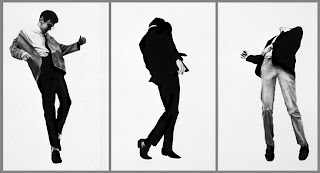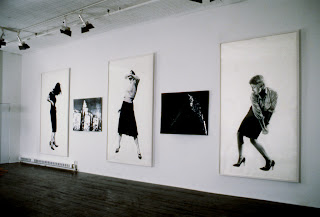Robert Longo, Untitled (Men in the Cities), 1979/2009, set of three black and white photo, 20 x 16 inches (paper), 50.8 x 40.6 cm.
Robert Longo (1953- ) bridged any gap that was left between art and popular culture. He made sculpture, paintings and music videos. Before Julian Schnabel became a film director Longo was making feature films. He made was has come to be known as the proto-Matrix film Johnny Mnemonic (1995) based on the short story by William Gibson.
Longo was associated with a group who arrived in New York from Buffalo in 1997. Among them were Charlie Clough, Nancy Dwyer, Cindy Sherman and Michael Zwack (Stangos, N., 1994, p.221).
Longo has created works in several media on contemporary situations.
MEN IN THE CITIES, 1979
Robert Longo (1953- ) bridged any gap that was left between art and popular culture. He made sculpture, paintings and music videos. Before Julian Schnabel became a film director Longo was making feature films. He made was has come to be known as the proto-Matrix film Johnny Mnemonic (1995) based on the short story by William Gibson.
Longo was associated with a group who arrived in New York from Buffalo in 1997. Among them were Charlie Clough, Nancy Dwyer, Cindy Sherman and Michael Zwack (Stangos, N., 1994, p.221).
Longo has created works in several media on contemporary situations.
MEN IN THE CITIES, 1979
Installation View - "The Pictures Generation"
2009
The Great Hall
The Metropolitan Museum of Art
New York, NY
Installation View - "The Pictures Generation"
Men in the Cities - Men Trapped in Ice
1980
The writer Richard Price suggested that Men in the Cities "reads like a warning. The dancers dressed in dropdeadchicless chic, are literally in danger of dropping dead" (Price, 19 p.87)
Installation View - Men in the Cities
1981
This is Richard Price's description of this series of work: "The vacuum sealed cityscapes now look like post neutron (real estate) bomb vistas. Dancing, dying, dancing- the figures remind me of hipped-up Brueghellian revellers in face of the plague; of Pompeiian lava casts of blasted silhouettes on Hiroshima walls as we all increasingly dance to the ticking of the nuclear clock" (Price, 1986 p.87). Longo's work is full of violence.
This is Richard Price's description of this series of work: "The vacuum sealed cityscapes now look like post neutron (real estate) bomb vistas. Dancing, dying, dancing- the figures remind me of hipped-up Brueghellian revellers in face of the plague; of Pompeiian lava casts of blasted silhouettes on Hiroshima walls as we all increasingly dance to the ticking of the nuclear clock" (Price, 1986 p.87). Longo's work is full of violence.
Men in the Cities: Final Life
1982
"Longo pulls his images from magazines, newspapers, movie stills- images we see so often we fail to see them any more. He exploits the image, monumentalizes it ties a D.O.A ticket to the big toe and offers us a potential vision of the near future" (1986, p.87)
Men in the Cities - Untitled
1982-84
The dancing figures emerge from the same cultural space that Longo occupied. The New Wave/No Wave scene and punk informed his work. He felt, in the late seventies part of same cultural fabric as bands like Talking Heads and "seeing bands like The Contortions fronted by James Chance . When he's on stage in new ways, moving hot and fast... It seems like the gestures in Men in the Cities are very much about the time we live in" (Price, 1986 p.88). The imagery of performances connects us to Allan Kraprow and Harold Rosenberg's reading of Jackson Pollock, the action painter.
The work grew directly from a film still from a Fassbinder film called An American Soldier taken at the end of the film where two gangsters are shot : "In its image is embedded a high impact kind of bang; at the same time it has this incredibly fluid grace, the speed of grace" (Price, 1986, p.88).
The dancing figures emerge from the same cultural space that Longo occupied. The New Wave/No Wave scene and punk informed his work. He felt, in the late seventies part of same cultural fabric as bands like Talking Heads and "seeing bands like The Contortions fronted by James Chance . When he's on stage in new ways, moving hot and fast... It seems like the gestures in Men in the Cities are very much about the time we live in" (Price, 1986 p.88). The imagery of performances connects us to Allan Kraprow and Harold Rosenberg's reading of Jackson Pollock, the action painter.
From An American Soldier
The work grew directly from a film still from a Fassbinder film called An American Soldier taken at the end of the film where two gangsters are shot : "In its image is embedded a high impact kind of bang; at the same time it has this incredibly fluid grace, the speed of grace" (Price, 1986, p.88).
Installation View - Men in the Cities
1981
Men in the Cities - Untitled
1980
Longo's figures seem to suffer a kind of disruption or pain.
Men in the Cities - Untitled
1980
It all sounds close to my memory of Ballard's writing.
There is something aggressive, apocalyptic and sometimes biblical and close to something that is now. It seems like some terrible prophecy.
Men in the Cities: Final Life (detail)
1981-82
Untitled
1981
Untitled
1982
"Men in the Cities were white people, no ethnic groupings just doomed souls. They're people who built the building that would eventually fall on them" (Price, 1986 p. 91).
Untitled (White Riot)
1982
When first confronted by Longo's drawings, I did not see people but saw something closer to a Franz Kline. Abstract rather than representational. A black abstract shape in a white space.
Sources:
Longo, R., Robert Longo: http://www.robertlongo.com/
Price, R., & Longo, R.,(1986) Men in the Cities 1979-1982 New York: Narry N. Abrams
Stangos, N & Read, H., (1994) The Thames and Hudson Dictionary of Art and Artists London: Thames and Hudson














No comments:
Post a Comment